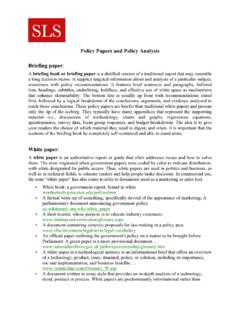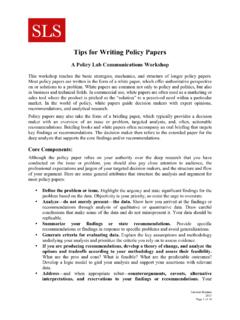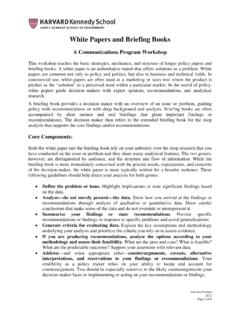Transcription of NBER WORKING PAPER SERIES ARE EMILY AND GREG MORE ...
1 NBER WORKING PAPER SERIESARE EMILY AND GREG MORE EMPLOYABLETHAN LAKISHA AND JAMAL?A FIELD EXPERIMENT ON LABOR MARKET DISCRIMINATIONM arianne BertrandSendhil MullainathanWorking PAPER 9873 BUREAU OF ECONOMIC RESEARCH1050 Massachusetts AvenueCambridge, MA 02138 July 2003 David Abrams, Victoria Bede, Simone Berkowitz, Hong Chung, Almudena Fernandez, Mary AnneGuediguian, Christine Jaw, Richa Maheswari, Beverley Martis, Alison Tisza, Grant Whitehorn, and ChristineYee provided excellent research assistance. We are also grateful to numerous colleagues and seminarparticipants for very helpful comments. The views expressed herein are those of the authors and notnecessarily those of the National Bureau of Economic Research 2003 by Marianne Bertrand and Sendhil Mullainathan. All rights reserved. Short sections of text not toexceed two paragraphs, may be quoted without explicit permission provided that full credit including notice, is given to the EMILY and Greg More Employable than Lakisha and Jamal?
2 A Field Experiment on LaborMarket DiscriminationMarianne Bertrand and Sendhil MullainathanNBER WORKING PAPER No. 9873 July 2003 JEL No. J7, J71, J23, J24, J63, J82, C93 ABSTRACTWe perform a field experiment to measure racial discrimination in the labor market. We respondwith fictitious resumes to help-wanted ads in Boston and Chicago newspapers. To manipulateperception of race, each resume is assigned either a very African American sounding name or a veryWhite sounding name. The results show significant discrimination against African-Americannames: white names receive 50 percent more callbacks for interviews. We also find that race affectsthe benefits of a better resume. For white names, a higher quality resume elicits 30 percent morecallbacks whereas for African Americans, it elicits a far smaller increase. Applicants living in betterneighborhoods receive more callbacks but, interestingly, this effect does not differ by race. Theamount of discrimination is uniform across occupations and industries.
3 Federal contractors andemployers who list Equal Opportunity Employer in their ad discriminate as much as otheremployers. We find little evidence that our results are driven by employers inferring somethingother than race, such as social class, from the names. These results suggest that racial discriminationis still a prominent feature of the labor BertrandSendhil MullainathanGraduate School of BusinessMITU niversity of Chicago50 Memorial Drive, E52-380a1101 East 58th Street, R0229 DCambridge, MA 02142 Chicago, IL 60637and NBERand IntroductionEvery measure of economic success reveals significant racial inequality in the US labor market. Comparedto Whites, African Americans are twice as likely to be unemployed and earn nearly 25 percent less whenthey are employed (Council of Economic Advisers, 1998). This inequality has sparked a debate on whetheremployers discriminate by race. When faced with observably similar African American and white applicants,do they favor the white one?
4 Some argue yes, citing either employer prejudice or employer perception thatrace signals lower productivity. Others argue that discrimination is a relic of the past, eliminated by somecombination of employer enlightenment, affirmative action programs and the profit-maximization fact, many in this later camp even feel that stringent enforcement of affirmative action programs hasproduced an environment of reverse discrimination. They would argue that faced with identical candidates,employers might favor the African American limitations make it difficult to empirically test theseviews. Since researchers possess far less data on workers than employers do, white and African Americanworkers that appear similar to researchers may look very different to employers. So any racial difference inlabor market outcomes could just as easily be attributed to these differences unobserved by researchers asto conduct a field experiment to circumvent this difficulty. We send resumes in response to help-wanted ads in Chicago and Boston newspapers and measure the number of callbacks each resume receivesfor interviews.
5 We experimentally manipulate perception of race via the name on the resume. We randomlyassign very white sounding names (such as EMILY Walsh or Greg Baker) to half the resumes and veryAfrican American sounding names (such as Lakisha Washington or Jamal Jones) to the other half. Becausewe are also interested in how credentials affect discrimination, we experimentally vary the quality of theresumes used in response to a given ad. Higher quality applicants have on average a little more labor marketexperience and fewer holes in their employment history; they are also more likely to have an email address,have completed some certification degree, possess foreign language skills or have been awarded some practice, we typically send four resumes in response to each ad: two higher quality and two lower qualityones. We randomly assign to one of the higher and one of the lower quality resumes an African Americansounding name. In total, we respond to over 1300 employment ads in the sales, administrative support,clerical and customer services job categories and send nearly 5000 resumes.
6 The ads we respond to cover alarge spectrum of job quality, from cashier work at retail establishments and clerical work in a mailroom tooffice and sales management find large racial differences in callback with white names need to send about1 This camp often explains the poor performance of African Americans in terms of supply factors. If African Americans lackmany basic skills entering the labor market, then they will perform worse, even with parity or favoritism in creating the higher quality resumes, we deliberately made small changes in credentials so as to minimize the chance ease of exposition, we refer to the effects uncovered in this experiment as racial differences. Technically, however, these210 resumes to get one callback whereas applicants with African American names need to send around 15resumes to get one callback. This 50 percent gap in callback rates is statistically very significant. Based onour estimates, a white name yields as many more callbacks as an additional eight years of experience.
7 Sinceapplicants names are randomly assigned, this gap can only be attributed to the name also affects the reward to having a better resume. Whites with higher quality resumes receive 30percent more callbacks than Whites with lower quality resumes, a statistically significant difference. On theother hand, having a higher quality resume has a much smaller effect for African Americans. In other words,the gap between white and African-Americans widens with resume quality. While one may have expectedthat improved credentials may alleviate employers fear that African American applicants are deficient insome unobservable skills, this is not the case in our therefore appears to bite twice,making it harder not only for African Americans to find a job but also to improve their experiment also reveals several other aspects of discrimination. First, since we randomly assignapplicants postal addresses to the resumes, we can study the effect of neighborhood of residence on theprobability of callback.
8 We find that living in a wealthier (or more educated or more white ) neighborhoodincreases callback rates. But, interestingly, African Americans are not helped more than Whites by livingin a better neighborhood. Second, the amount of discrimination we measure by industry does not appearcorrelated to Census-based measures of the racial gap by industry. The same is true for the amount ofdiscrimination we measure in different occupations. In fact, we find that discrimination levels are statisticallyindistinguishable across all the occupation and industry categories covered in the experiment. We also findthat federal contractors, who are thought to be more severely constrained by affirmative action laws, donot discriminate less; neither do larger employers or employers who explicitly state that they are an EqualOpportunity Employer in their ads. In Chicago, we find that employers located in more African Americanneighborhoods are slightly less likely to rest of the PAPER is organized as follows.
9 Section 2 compares this experiment to prior work ondiscrimination, and most notably to the labor market audit studies. We describe the experimental designin Section 3 and present the results in Section In Section 5, we discuss possible interpretations ofour results, focusing especially on two issues. First, we examine whether the race-specific names we havechosen might also proxy for social class above and beyond the race of the applicant. Using birth certificatesdata on mother s education for the different names used in our sample, we find little relationship betweensocial background and the name specific callback , we discuss how our results map backeffects are about the racial soundingness of names. We briefly discuss the potential confounds between name and race belowand more extensively in Section results contrast with the view, mostly based on non-experimental evidence, that African Americans receive higherreturns to skills. For example, estimating earnings regressions on several decades of Census data, Heckman et al.
10 (2001) showthat African Americans experience higher returns to a high school degree than also argue that a social class interpretation would find it hard to explain all of our results, such as why living a betterneighborhood does not increase callback rates more for African American names than for white the different models of discrimination proposed in the economics literature. In doing so, we focus ontwo important results: the lower returns to credentials for African Americans and the relative homogeneityof discrimination across occupations and industries. We conclude that existing models do a poor job ofexplaining the full set of findings. Section 6 Prior Research on DiscriminationWith conventional labor force and household surveys, it is difficult to measure racial discrimination or analyzeits survey data, researchers usually measure discrimination by comparing the labor marketperformance of Whites and African Americans who report a similar set of skills.
















